Infrastructure
Bengaluru Suburban Rail: 10 Possible Rail Routes To Decongest India’s Silicon Valley
Ashwin S Kumar
Jan 18, 2017, 08:25 PM | Updated 08:25 PM IST
Save & read from anywhere!
Bookmark stories for easy access on any device or the Swarajya app.


A decade-long demand of Bengaluru residents has finally been heard with the city finally moving towards building a commuter rail system. Union railway minister Suresh Prabhu recently signed a Memorandum of Understanding with the Government of Karnataka for utilising the megacity’s existing railway infrastructure to operate commuter rail services similar to that in Mumbai and Chennai.
As part of the deal, Karnataka will pitch in 80 per cent of the cost to convert 15 trains to electric multiple units while Indian Railways will take care of the rest. The total cost is pegged currently at Rs 360 crore. And the first train is set to have Ramanagara, 35 km outside the city, as its destination point.
It has been a long journey trying to get commuter rail service started in Bengaluru, a city that already has a metro rail system, with a light rail system also in the docks. Although far from perfect, suburban rail is the most practical and cost-friendly solution to ease Bengaluru’s traffic problems. You get such advantages as:
- Rail lines already exist
- Land acquisition not required
- No time spent on construction
- No felling of trees or digging underground
- No inconvenience to existing commuters
The only additional thing required is passenger trains. Weighing the costs and benefits of implementing this system, the choice becomes clear.
Okay, so now that commuter rail is set to materialise, it’s worthwhile to discuss what the possible rail routes could be. Based on a map of railway lines across the city, this writer has attempted to come up with ten rail routes that could work. (Do note that this writer does not have real data on how many users would benefit from the proposed routes and what exact impact it would have on traffic -- the math on this is yet to be done.) So here are ten possible suburban rail routes:
1. Bidadi-Nelamangala (via Bangalore City railway station (Krantivira Sangolli Rayanna railway station), Malleshwaram, Yeshwantpur)
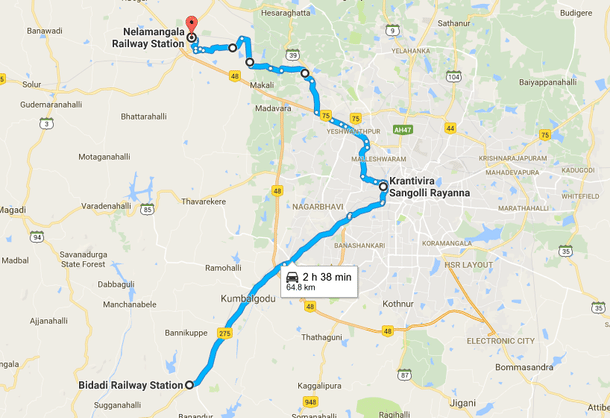
People residing along Mysore Road and near Peenya would especially benefit from this rail route. It will also connect two highways, namely Mysore Road and Tumkur Road.
A mapping of possible beneficiaries:
a) Bidadi: Factory workers, Innovative Film City visitors, Nithyananda devotees
b) Hejjala: Wonder La visitors
c) Kengeri: Kengeri Satellite Town residents, Big Banyan Tree tourists
d) Gnanabharathi: Students and staff of R V College of Engineering and Bengaluru University, Global Village Tech Park employees, residents of Rajarajeshwari Nagar and Nagarbhavi (key station)
e) Nayandahalli: Residents of Rajarajeshwari Nagar, Nagarbhavi and Chandra Layout (makeshift stations -- one platform each at RPC Layout and ETA Mall would be even better), students and staff of PESIT and neighbouring colleges (another key station)
f) Bangalore City railway station: Direct connectivity to the city’s main railway station is a must.
g) Malleshwaram: This locality attracts a lot of people. With this route, a commute from Gnanabharathi to Malleshwaram, for instance, which now takes an hour or more, would take about a half-hour.
h) Yeshwanthpur: Another important locality. Rail connectivity to this area would benefit a lot of people.
i) Nelamangala: Several educational institutions and industries are situated in this area. Students and workers alike would benefit as a result.
Even just three trains in a day, one in the morning peak-hour, one in the afternoon time and one in the evening peak-hour, would help reduce traffic along Tumkur Road and NICE Road significantly.
2. Bidadi-Whitefield (Bangalore City railway station, Cantonment, Baiyappanahalli, K R Puram)
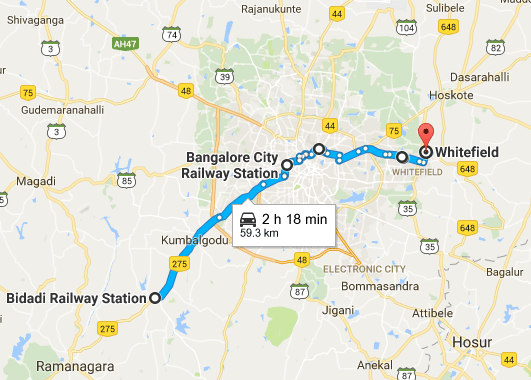
This would help anyone living in and around Mysore Road commute to the eastern limits of Bengaluru with relative ease. A train from Bidadi to Whitefield via Bangalore City railway station, Cantonment and K R Puram will combat traffic congestion effectively.
3. Nelamangala-Whitefield (via Yeshwanthpur, Bangalore City railway station)

This rail line can connect North-West Bengaluru to East Bengaluru. If one wants to travel from Nelamangala to Whitefield in the present, it’s quite a difficult commute. For instance, one would have to go to Nagasandra, take the Green Line up to Mantri Mall, take a bus from there to Majestic, take the Purple Line from there to Baiyappanahalli and then take a bus from there. A direct train along this route, therefore, would do wonders for regular commuters.
4. Nelamangala-Heelalige (via Yeshwanthpur, Lottegollahalli, Hebbal, Banaswadi, Bellandur)

Besides Whitefield, which other areas in Bengaluru would one consider super-congested? Topping the list of many would be the localities of Marathahalli and Electronic City.
This proposed rail line will connect North-West and South-East Bengaluru. The city’s employees, especially IT employees, would be most benefited by this line. It would also greatly reduce traffic on Old Airport Road. Anyone commuting to Marathahalli from the north-west side and vice versa would also have it easier.
5. Bidadi-Heelalige (Bangalore City railway station, Baiyappanahalli, Bellandur)

Similar to the previous line, this route will help link areas near Mysore Road to Bellandur and Electronic City. In effect, it will reduce the dependence on NICE Road and Old Airport Road, which would be a significant.
6. Bidadi-Banaswadi (Bangalore City railway station, Yeshwanthpur, Hebbal)
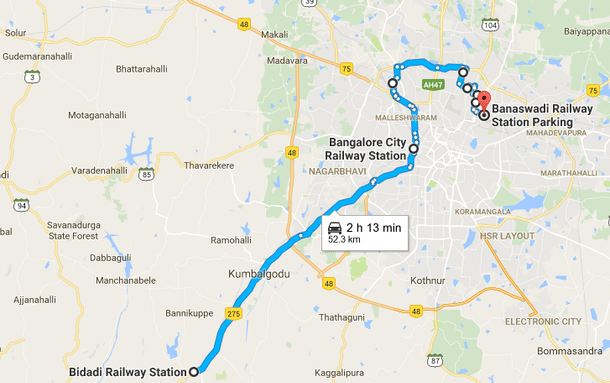
This line would benefit residents who commute regularly from Mysore Road to Hebbal and vice versa. It will significantly reduce the dependence on Outer Ring Road as well.
7. Whitefield-Heelalige (via Baiyappanahalli, Bellandur)
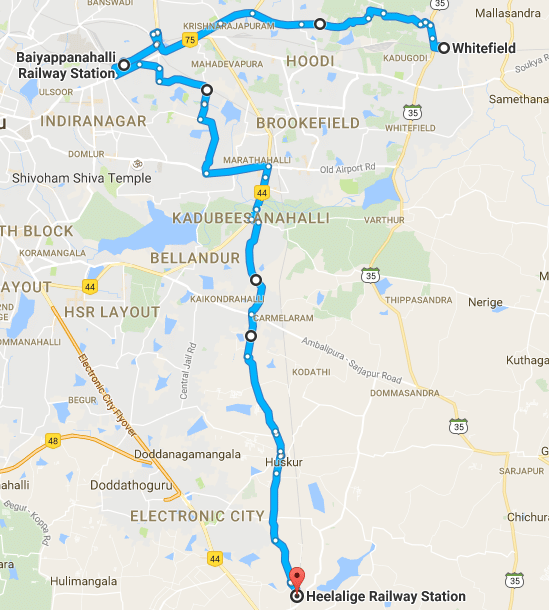
A direct railway line linking the two major Information Technology hubs of the city cannot help but be a boon for Bengaluru’s large and growing IT crowd.
Rail routes to the airport (to be introduced with the highest priority)
As if there isn't enough traffic in Bengaluru already, a commute to the city’s airport is close to a nightmare for those living far from it. In most cases, flying from Bengaluru to another city and beyond takes lesser time than commuting from one's house to the airport -- that is how far it is!
Taking the BIAL (airport) bus is possible only when one has a lot of time on their hands. Otherwise, one has to rely on cabs, which can take anywhere from one-and-a-half to two hours, depending on where one is starting their commute from.
So then, what is the solution for a quicker commute to the airport? Suburban rail. The city already has a rail line that goes by the airport. So that can be used. Every major city in the world has rail connectivity to its airport. Bengaluru, despite being a world-class city, unfortunately does not.
Besides trains, the only additional thing required would be a railway station near the airport. The ideal location to construct this station would be as shown on the map:
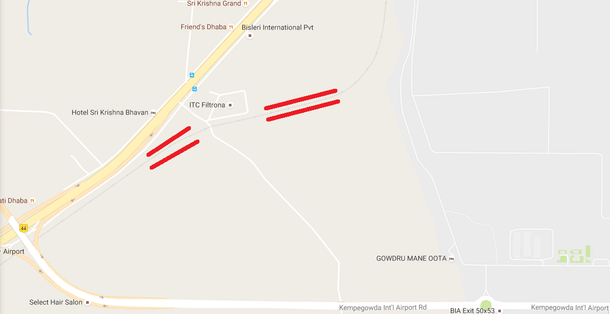
The airport railway station could be built on either of the two locations marked by red lines. These trains, while primarily serving the purpose of airport commute, can be extended to Nandi Halt. If this is done, it would help tourists heading to Nandi Hills as well.
It would be preferred that these trains operate round the clock, as many international flights depart in the middle of the night.
8. Bidadi-Nandi Halt (via Bangalore City railway station, Yeshwanthpur, Lottegollahalli, Yelahanka, Kempegowda International Airport)

There are two ways of implementing this route, namely through Yeshwanthpur (recommended) and through Baiyappanahalli (because this station will or should already facilitate the connection from Heelalige).
9. Heelalige-Nandi Halt (via Baiyappanahalli, Channasandra, Yelahanka, Kempegowda International Airport)
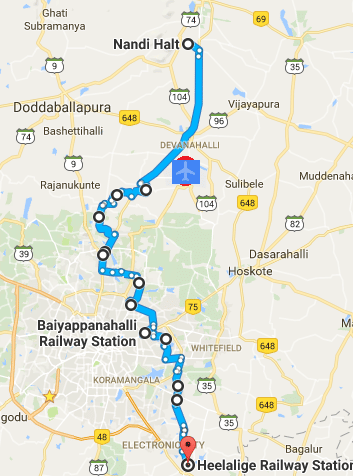
Since a majority of the IT population resides in Electronic City area -- and they’re more likely to take the flight than the average Bengalurean, this rail link is bound to be effective.
10. Whitefield-Nandi Halt (via K R Puram, Yelahanka, Kempegowda International Airport)
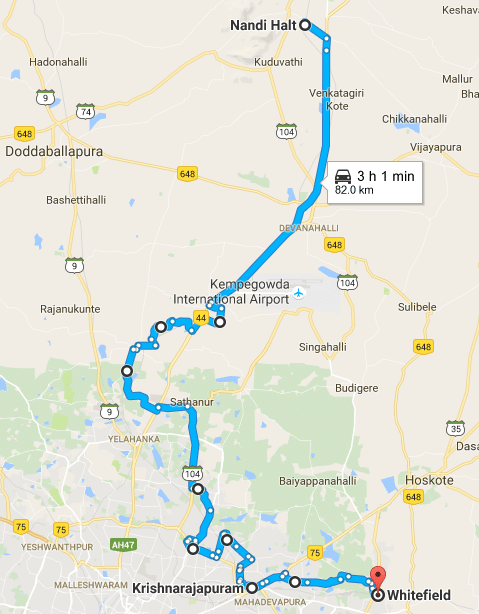
This is as crucial as the Electronic City-airport link. These two routes should be sufficient to keep a lot of cars off the airport road.
In conclusion, I believe that if trains are introduced on these specific routes with a reasonable frequency, it can help decongest the roads and reduce overall traffic, turning Bengaluru into the paradise that it once used to be. Now, wouldn’t we all want that for Namma Bengaluru?
Ashwin is a Benglurean born in Chennai, former columnist at The UnReal Times, amateur musician, and a devotee of Harris Jayaraj.




